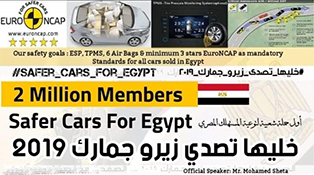FIA
Day 3 of 4th United Nations Global Road Safety Week - How FIA and United Nations team up to Save Lives - #slowdown
Therefore we at Auto Arabia teamed up with the Automobile & Touring Club of Egypt ATCE in order to raise the public and media awareness about this extremely important issue, as our part and contribution to the 4th United Nations Global Road Safety Week and to the efforts of the FIA in improving the road safety situation worldwide.
During this Global Road Safety Week we will see Auto Arabia’s editor-in-chief Mohamed Sheta cooperating closely with the Automobile & Touring Club of Egypt and its Traffic & Tourism Committee. Sheta is not only an influential automotive journalist and well-known jury-member in six internationally-renowned automotive awards with over 25 years of experience in the automotive, motorsport and media sector, but he is also an internationally-acknowledged road safety advocate speaking regularly in fluent German, Arabic, and English at regional and international automotive and road safety conferences.
Sheta will be talking daily here on autoarabia.org and on several radio and TV channels about the most challenging problems and obstacles facing the road safety efforts and goals in Egypt and how adapting a #slowdown strategy could save lives among all road users, and not only among the passenger car drivers.
This extensive media activity is aimed primarily at reaching millions of road users, internet users, TV viewers and radio listeners but at the same time will also reach the political decision-makers and stake-holders.
On each day of this road safety week Mohamed Sheta will tackle a different road safety topic/problem, and explain how to adapt effective solution for those road safety problems based on the current circumstances in Egypt and based on the behavior and understanding of the Egyptian road user.
During the seven days of the 4th UN Global Road Safety week Sheta will talk about the following seven topics:
- 08.05.2017: Risks of speeding for passenger car drivers
- 09.05.2017: Risks of speeding for motorcycle riders
- 10.06.2017: Risks of speeding for microbus, minibus, public transportation bus, tourism bus and taxi drivers
- 11.06.2017: Risks of speeding for Light Commercial Vehicle drivers
- 12.06.2017: Risks of speeding for Heavy Goods Vehicle drivers
- 13.05.2017: The role of the government, the private sector, the NGOs, the public & private schools, the public & private universities and the law enforcement authorities
- 14.05.2017: The importance of the use of modern technology and ITS by the law enforcement and the importance of active and passive safety features in the passenger cars, motorcycles, buses, LCVs and HGV for reducing the braking distances
So today on the 10th of May 2017, the third day of the 4th UN Global Road Safety week, Sheta will be talking about the risks of speeding for microbuses, minibuses, public transportation buses, tourism buses and taxi drivers:
‘It is no secret that the huge 14-seater-microbus and 28-seater-minibus fleets in Egypt, dominated for decades by the Japanese Toyota Hi-Ace and its Chinese copy from Jin Bein, is an essential complementation to the public transportation sector, which would probably collapse without all those privately-owned microbuses and minibuses.
The problem with those low-budget Jin Bein microbuses imported by the Bavarian Auto Group (which is the official BMW and MINI importer in Egypt) and the low-quality minibuses assembled in Egypt by General Motors Egypt, is that all those models do not have any active or passive safety whatsoever. They do not even have any credible crash-test certificates.
The Nissan Urvan microbus imported by Nissan Motors Egypt does not even have headrests for the passengers.
Even the so-called ‘Rolls Royce’ among the microbuses, the Toyota Hi-Ace, is imported and sold in Egypt by Toyota Egypt Alfuttaim without enough airbags and without ESP.
Needless to say is that 99% of those microbuses and minibuses do not have even seatbelts.
Even the bigger 52-seater buses assembled in or imported to Egypt lack the latest active and passive safety features.
Not surprisingly do we hear every few days about horrific accidents involving those dangerous and unsafe microbuses, minibuses and buses, sadly with dozens of fatalities. One road crash in winter 2015 involving two microbuses resulted in the death of 28, yes TWENTY-EIGHT innocent passengers!
The Egyptian government must take serious steps in order to stop the death of innocent people using those microbuses, minibuses and buses. Those steps must be:
1.) All microbuses, minibuses and buses assembled in Egypt or imported to Egypt must come with ABS, ESP, Tire Pressure Monitoring System, seatbelts and headrest for all passengers and emergency braking system.
2.) The Egyptian government must introduce new driving permit tests according to the EU standards, which all those commercial drivers must pass.
3.) Set new speed limits for all microbuses, minibuses and buses on all roads in Egypt.
4.) More police control inside and outside the cities, with a special focus on the drivers of those microbuses, minibuses, buses and taxis as they have a much higher responsibility than the drivers of small passenger cars.
I hope the Egyptian government will take serious steps as soon as possible. Until then my request and recommendations to all the drivers of microbuses, minibuses, public transportation buses, tourism buses and taxis: please #slowdown and save lives!’
AA
10.05.2017
Cairo
Related articles:
#SaferCarsForEgypt
 Want to sell your used car or buy one? Then check out our new used car market section
here!
Want to sell your used car or buy one? Then check out our new used car market section
here!
 Looking for a good service center or aftersales customer service? Did you have any bad experience with your car dealer or service center? Then check our 'automotive evaluation charts'
here!
Looking for a good service center or aftersales customer service? Did you have any bad experience with your car dealer or service center? Then check our 'automotive evaluation charts'
here!
Is Egyptian car market corrupt or collapsing?

Is the Egyptian car market collapsing or is it just a corrupt and unprofessional car market?
This is surely one of the most asked questions these days. Everybody is asking ...
AutoArabia Consulting
Middle East Car of the Year

Read more
Crash Test Results

Subscribe





 Volvo Cars receives highest possible sustainability ...
Volvo Cars receives highest possible sustainability ... Nicolas Fuchs steers Borgward BX7 DKR to 3rd place at ...
Nicolas Fuchs steers Borgward BX7 DKR to 3rd place at ... VOLVO XC60 IS THE NEW 2018 WORLD CAR OF THE YEAR
VOLVO XC60 IS THE NEW 2018 WORLD CAR OF THE YEAR Jaguar Middle East launches F-PACE 2.0 WITH NEW 250PS ...
Jaguar Middle East launches F-PACE 2.0 WITH NEW 250PS ... Egypt-Exclusive: First Drive of Volvo XC60 – Is it ...
Egypt-Exclusive: First Drive of Volvo XC60 – Is it ... FIA OFFICIAL STATEMENT FOLLOWING THE 2017 AZERBAIJAN F1 ...
FIA OFFICIAL STATEMENT FOLLOWING THE 2017 AZERBAIJAN F1 ... Volvo Cars safety experts receive prestigious award ...
Volvo Cars safety experts receive prestigious award ... Geneva Show 2017: All-new Volvo XC60 SUV will ...
Geneva Show 2017: All-new Volvo XC60 SUV will ... Formula E 2017 season: Renault e.dams win opening race ...
Formula E 2017 season: Renault e.dams win opening race ... XC90 and 90 series help Volvo Cars report impressive ...
XC90 and 90 series help Volvo Cars report impressive ...




